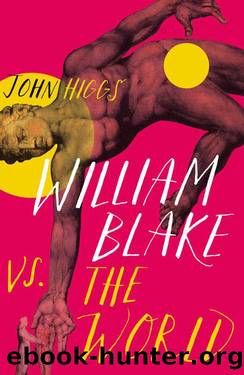William Blake vs the World by John Higgs

Author:John Higgs [Higgs, John]
Language: eng
Format: epub
ISBN: 9781474614351
Publisher: W&N
Published: 2021-05-05T23:00:00+00:00
10.
APPEARD AS ONE MAN
William Blake spent most of the 1790s in a small brick terraced house with a garden in Lambeth, south of the Thames, were he lived with Catherine and a large wooden printing press. It was a decade of extraordinary creative productivity and relative stability â arguments about extramarital affairs aside.
The decade began with the printing of The Marriage of Heaven and Hell in 1790. In this, he casually states, âI have also; The Bible of Hell: which the world shall have whether they will or no.â Blake scholars generally consider the name âBible of Hellâ to refer to the bulk of the illuminated books he produced during this decade. There has been much academic debate about exactly which works should be thought of as part of Blakeâs Bible of Hell and which are outside the Hell Bible âcanonâ. The short works that explore characters from Blakeâs emerging personal mythology â The Song of Los (1795), The First Book of Urizen (1794), The Book of Ahania (1795), and The Book of Los (1795) â are generally accepted as included, while arguments have been made to include the longer works Europe a Prophecy (1794) and America a Prophecy (1793), as well as The Marriage of Heaven and Hell itself.
Alongside the work that makes up the Bible of Hell, he produced âVisions of the Daughters of Albionâ (1793) and Songs of Experience (1794) in the same decade, as well as much paid engraving work for other people that generated the bulk of his income. Disappointingly, he could only find a handful of buyers for his own illuminated books. Most typically achieved sales in single figures. This made his revolutionary printing technique a little redundant, as it was designed for mass reproduction. Yet a lack of audience did not deter him from his labour, and it is hard not to be impressed by the quantity and quality of work he generated during this inspired and productive decade â even before you factor in the watercolours and other artworks he produced. These include some of his most famous, including Newton and Nebuchadnezzar, which were first produced in 1795.
At the start of the decade, Blake was still optimistic that his new printing technique would be the key to financial success. In October 1793, he produced a prospectus headed âTO THE PUBLICâ, which detailed his various works for sale. It begins with the declaration, âThe Labours of the Artist, the Poet, the Musician, have been proverbially attended by poverty and obscurity; this was never the fault of the Public, but was owing to a neglect of means to propagate such works as have wholly absorbed the Man of Genius. Even Milton and Shakespeare could not publish their own works.â Blake then outlines his new printing method, which he claims âproduces work at less than one fourth of the expenseâ.
âIf a method of Printing which combines the Painter and the Poet is a phenomenon worthy of public attention, provided that it exceeds in elegance all former methods, the Author is sure of his reward,â he wrote.
Download
This site does not store any files on its server. We only index and link to content provided by other sites. Please contact the content providers to delete copyright contents if any and email us, we'll remove relevant links or contents immediately.
Machine Learning at Scale with H2O by Gregory Keys | David Whiting(4106)
Never by Ken Follett(3762)
Harry Potter and the Goblet Of Fire by J.K. Rowling(3759)
Unfinished: A Memoir by Priyanka Chopra Jonas(3314)
Fairy Tale by Stephen King(3193)
The Man Who Died Twice by Richard Osman(2979)
Will by Will Smith(2770)
Rationality by Steven Pinker(2272)
The Dark Hours by Michael Connelly(2216)
It Starts With Us (It Ends with Us #2) by Colleen Hoover(2174)
The Storyteller by Dave Grohl(2150)
Can't Hurt Me: Master Your Mind and Defy the Odds - Clean Edition by David Goggins(2147)
The Dawn of Everything: A New History of Humanity by David Graeber & David Wengrow(2104)
Friends, Lovers, and the Big Terrible Thing by Matthew Perry(2100)
The Becoming by Nora Roberts(2061)
The Stranger in the Lifeboat by Mitch Albom(2031)
Cloud Cuckoo Land by Anthony Doerr(2012)
Einstein: His Life and Universe by Walter Isaacson(1952)
Love on the Brain by Ali Hazelwood(1931)
